
By the SRSrocco Report,
As the Mainstream media reports about the next phase of the glorious U.S. Shale Oil Revolution, the financial carnage continues to gut the industry deep down inside the entrails of its horizontal laterals. The stench of fracking fluid must be driving shale oil advocates utterly insane as they are no longer able to see the financial wreckage taking place in these companies quarterly reports.
This weekend, one of my readers sent me the following Bloomberg 45 minute TV special titled, The Next Shale Revolution. If you are in need of a good laugh, I highly recommend watching part of the video. At the beginning of the video, it starts off with President Trump stating that the U.S. has become an energy exporter for the first time ever. Trump goes on to say, "that powered by new innovation and technology, we are now on the cusp of a new energy revolution." While I have to applaud Trump's efforts for putting out some positive and reassuring news, I wonder who is providing him with terribly inaccurate energy information.
I would kindly like to remind the reader; the United States is still a NET IMPORTER of oil. We still import nearly six million barrels of oil per day, but we export some finished products and a percentage of our shale oil production. Thus, we still import a net of approximately three million barrels per day of oil.
A few minutes into the Bloomberg video, both Pioneer Resources Chairman, Scott Sheffield, and Continental Resources CEO, Harold Hamm, explain how advanced technology will revolutionize the shale oil industry and bring down costs. I find that statement quite hilarious as Continental Resources and Pioneer continue to spend more money drilling for oil and gas then they make from their operations. As I stated in a previous article, Continental Resources long-term debt ballooned from $165 million in 2007 to $6.5 billion currently. So, how did advanced technology lower costs when Continental now has accumulated debt up to its eyeballs?
Of course... it didn't. Debt increased on Continental Resources balance sheet because shale oil production wasn't profitable... even at $100 a barrel. So, now the investor who purchased Continental bonds and debt are the Bag Holders.
Regardless, while U.S. oil production continues to increase at a moderate pace, there are some troubling signs in one of the country's largest shale oil fields.
Shale Oil Production At the Mighty Eagle Ford Stagnates As Companies' Financial Losses Mount
It was just a few short years ago that the energy industry was bragging about the tremendous growth of shale oil production at the mighty Eagle Ford Region in Texas. At the beginning of 2015, Eagle Ford oil production peaked at a record 1.7 million barrels per day (mbd). Currently, it is nearly 500,000 barrels per day lower. According to the EIA - U.S Energy Information Agency's most recently released Drilling Productivity Report, oil production in the Eagle Ford is forecasted to grow by ZERO barrels in December:
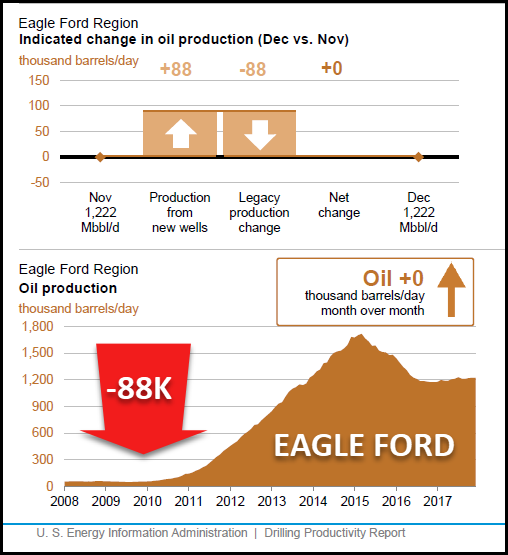
The chart above suggests that the companies drilling and producing oil in the Eagle Ford spent one hell of a lot of money, just to keep production flat. Even though the shale oil producers were able to bring on 88,000 barrels per day of new oil, the field lost 88,000 barrels per day due to legacy declines. We need not take out a calculator to understand production growth at the Eagle Ford is a BIG PHAT ZERO.
Here are the five largest shale oil and gas producers in the Eagle Ford where:
- EOG Resources
- ConocoPhillips
- BHP Billiton
- Chesapeake Energy
- Marathon Oil
The company that doesn't quite fit in the energy group above is BHP Billiton. BHP Billiton is one of the largest base metal mining companies in the world. Unfortunately for BHP Billiton, the company decided to get into U.S. Shale at the worst possible time. BHP Billiton bought shale oil properties when prices were high and eventually had to liquidate when prices were low. A Rookie mistake made by supposed professionals. I wrote about this in my article; DOMINOES BEGIN TO FALL: BHP Chairman Says $20 Billion Shale Investment “MISTAKE.”
I decided to take a look at the current financial reports published by the five companies listed above. The largest player in the Eagle Ford is EOG Resources. I went to YahooFinance and created the following Cash Flow table for EOG:
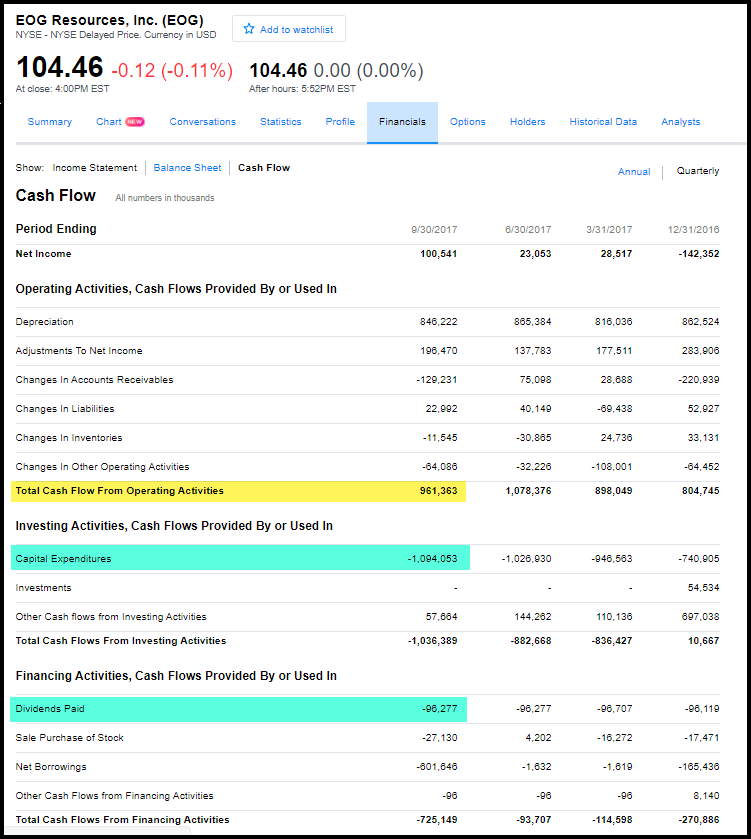
In the latest quarter (Q3 2017), EOG reported $961 million in cash from operations. However, the company spent $1,094 million on capital (CAPEX) expenditures and another $96 million in shareholder dividends. Applying simple arithmetic, EOG spent $229 million more on CAPEX and dividends than it made from its operations. Maybe someone can tell me how advanced technology is bringing down the cost for EOG.
The next largest player in the Eagle Ford is ConocoPhillips. If we look at ConocoPhillips net income at its different business segments, we can see that the company isn't making any money producing oil and gas in the lower 48 states:

While ConocoPhillips enjoyed a $103 million profit in Alaska, it suffered a $97 million loss in the lower 48 states. Thus, the third largest oil company in the U.S. isn't making any money producing oil and gas in the majority of the country. According to the data, ConocoPhillips produced twice as much oil and gas in the lower 48 states then what they reported in Alaska, but the company still lost $97 million.
The third largest company producing oil in the Eagle Ford is BHP Billiton. Instead of providing financial results, I thought this chart on BHP Billiton's Return On Capital Employed was a better indicator of how bad their U.S. Shale assets were performing. If we look at the right-hand side of the chart, BHP Billiton's shale oil resources have become one hell of a drag on the company's asset portfolio:
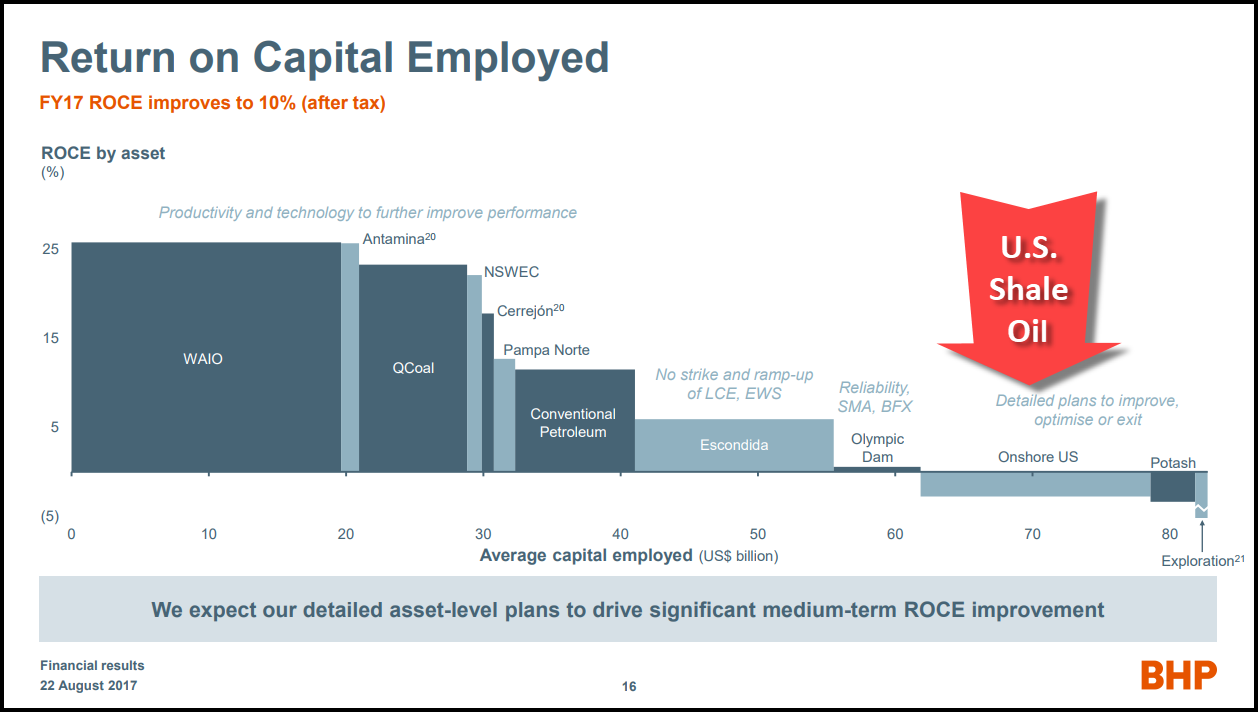
While BHP Billiton is enjoying a healthy positive Return On Capital Employed on most of its assets, shale oil resources are showing a negative return. Furthermore, the company makes a note to above stating, "Detailed plans to improve, optimize or EXIT." I would bet my bottom Silver Dollar that their decision will end up "EXITING" the wonderful world of shale energy, with the sale of their assets for pennies on the dollar.
Moving down the list to the next shale company, we come to Chesapeake. While Chesapeake is the country's second-largest natural gas producer, the company has been losing money for more than a decade. Unfortunately, the situation hasn't improved for Chesapeake as its current financial statement reveals the company continues to burn through cash to produce its oil and gas:
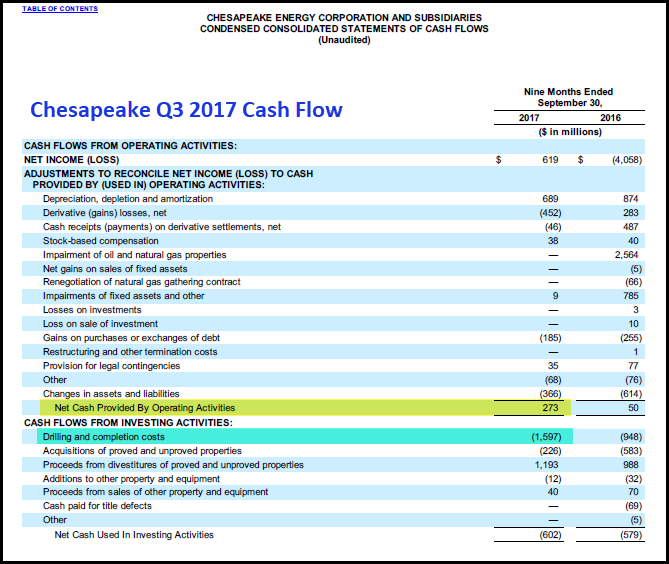
Chesapeake's net cash provided by its operating activities equaled $273 million for the first three-quarters of 2017. However, the company spent a whopping $1,597 million on drilling and completion costs (CAPEX). Thus, Chesapeake spent $1.3 billion more on producing its oil and natural gas Q1-Q3 2017 than it made from its operations. Again, how is advanced technology making shale oil and gas more profitable?
If it weren't for the asset sale of $1,193 million, Chesapeake would have needed to borrow that money to make up the difference. Regrettably, selling assets to fortify one's balance sheet isn't a long-term viable business model. There are only so many assets one can sell, and at some point, in the future, the market will realize those assets will have turned into worthless liabilities.
Okay, we finally come to the fifth largest player in the Eagle Ford.... Marathon Oil. The situation at Marathon isn't any better than the other companies drilling and producing oil in the Eagle Ford. According to the companies third-quarter report, Marathon suffered a $600 million net income loss:
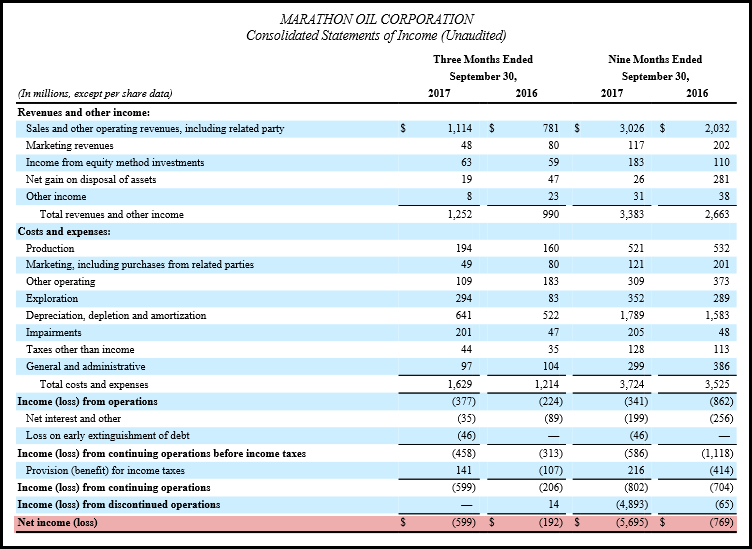
Again, we have another example of an energy company losing a lot of money producing shale oil and gas. You will notice how high Marathon's Depreciation, depletion, and amortization are in both the third-quarter and nine months ending on Sept 30th. While some may believe this is just a tax write off for the company... it isn't. Due to the massive decline rate in producing shale oil and gas, PLEASE SEE the FIRST CHART ABOVE on the EAGLE FORD GROWTH OF ZERO, these companies have to write off these assets as it represents the BURNING of CASH.
For example, Marathon reported cash from operations of $1,487 million for Q3 2017. However, it spent $1,305 million on CAPEX and $128 million on dividends for a total of $1,433 million. Thus, Marathon actually enjoyed a small $53 million in positive free cash flow once dividends were deducted. But, that is only part of the story. If we go back to 2005 when the oil price as about the same as it is today, Marathon was reporting quarterly profits, not losses.
In the first quarter of 2005, Marathon earned a positive $324 million in net income. It also reported a $258 million net income gain in 2004, even at a much lower oil price of $38 a barrel versus the $48-$50 during Q3 2017. So, the Falling EROI - Energy Returned On Invested is killing the profitability of shale oil and gas companies today, whereas they were making profits just a decade ago.
Now, I didn't provide any data on the other shale oil fields in the U.S., but production continues to increase in several regions, especially in the Permian. However, one of the largest players in the Permian, Pioneer Resources, isn't making any money either. If we look at their financials, we can see that Pioneer continues to spend more money on CAPEX than they are receiving from cash from operations:
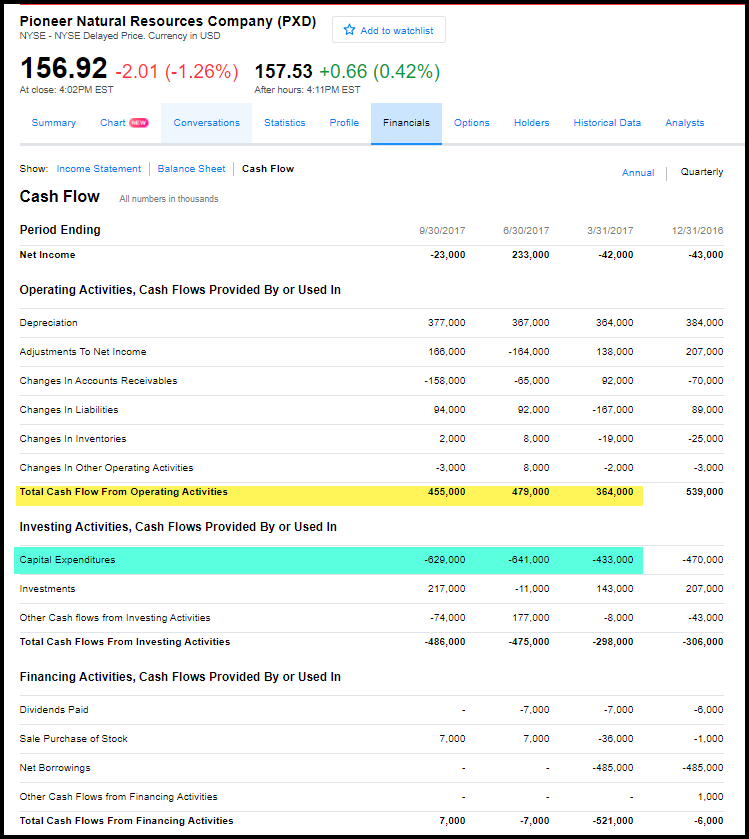
In all three quarters in 2017, Pioneer spent more money on capital expenditures than it made from its operating activities. Pioneer spent $400 million more on CAPEX spending than from its operations for the first nine months of 2017 ending on Sept 30th. So, here is just another example of a U.S. shale oil producer who partly responsible for the rising production in the Permian, but it still isn't making any money.
Now, some investors or readers on my blog would say that the situation will get better when the oil price continues towards $60, $70 and then $80 a barrel. Well, that would be nice, but I believe we are heading towards one hell of a market crash. Even though some economic indicators are looking rosy, this market is being propped up by a massive amount of debt and the largest SHORT VIX trade in history. When the markets start to go south as the massive VIX TRADE reverses... well, watch out below.
Thus, as the markets crash, the oil price will head down with it. Unfortunately, this will be the final blow to the U.S. Shale Oil Ponzi Scheme and with it... the notion of Energy Independence forever.
Check back for new articles and updates at the SRSrocco Report.



0 comments:
Post a Comment